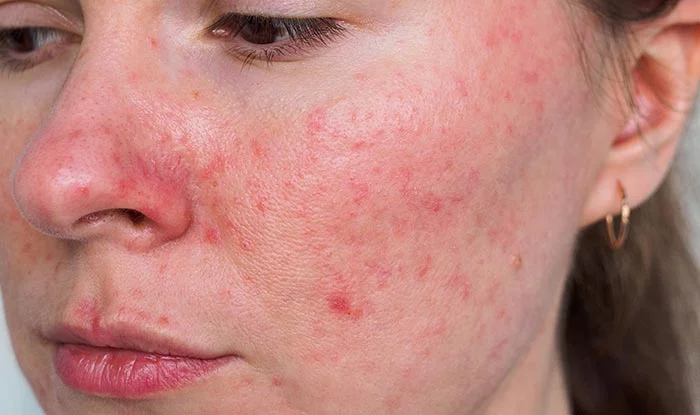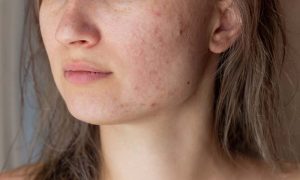Soothing Solutions: How to Calm and Cure Rosacea
Rosacea

Rosacea is a chronic skin condition that affects millions of individuals worldwide, causing redness, visible blood vessels, and sometimes acne-like breakouts on the face. While there is currently no cure for rosacea, there are numerous strategies and soothing solutions to manage its symptoms effectively. In this comprehensive guide, we will explore the causes, its symptoms, and proven methods to calm and alleviate this skin condition.
 Understanding Rosacea:
Understanding Rosacea:
It is a common, yet often misunderstood, skin disorder that primarily affects the face. The exact cause of rosacea is not fully understood, but a combination of genetic, environmental, and vascular factors is believed to contribute to its development. Common triggers for rosacea include exposure to sunlight, extreme temperatures, spicy foods, alcohol, stress, and certain skincare products.
Symptoms:
1. Facial Redness:
Persistent redness on the central part of the face, such as the nose, cheeks, forehead, and chin.
2. Visible Blood Vessels:
Small blood vessels becoming visible on the surface of the skin (telangiectasia).
3. Bumps and Pimples:
Acne-like breakouts, often referred to as papules and pustules, can appear on the face.
4. Eye Irritation:
In some cases, rosacea may affect the eyes, causing irritation, dryness, and redness (ocular rosacea).
5. Thickened Skin:
Over time, the skin on the nose may thicken and enlarge, a condition known as rhinophyma (more common in men).
Soothing Solutions:
1. Gentle Cleansing:
Start with a gentle skincare routine. Avoid harsh scrubbing or using hot water, as these can exacerbate redness and irritation. Opt for products specifically formulated for sensitive skin.
2. Hypoallergenic Products:
Choose hypoallergenic skincare and makeup products to minimize the risk of irritation. Look for labels that indicate “fragrance-free” and “non-comedogenic” to ensure that the products won’t trigger or worsen rosacea symptoms.
3. Sun Protection:
Sun exposure is a common trigger for rosacea flare-ups. Choose a physical sunscreen containing zinc oxide or titanium dioxide, as these ingredients are less likely to cause irritation.
4. Topical Treatments:
Topical medications prescribed by a dermatologist can help manage rosacea symptoms. These may include metronidazole, azelaic acid, or ivermectin. It’s essential to follow your dermatologist’s recommendations for application and be patient, as improvements may take some time.
5. Avoid Trigger Foods:
Identify and avoid foods and beverages that trigger your rosacea symptoms. Common triggers include spicy foods, hot drinks, alcohol, and certain food additives. Keeping a diary to track flare-ups can help identify specific triggers.
6. Cooling and Anti-Inflammatory Ingredients:
Incorporate skincare products with calming and anti-inflammatory ingredients, such as aloe vera, chamomile, green tea extract, or calendula. These ingredients can help soothe redness and reduce inflammation.
7. Moisturize Regularly:
Opt for products containing ingredients like hyaluronic acid or ceramides, which help maintain the skin barrier without causing irritation.
8. Stress Management:
Practice stress-reducing techniques such as meditation, deep breathing exercises, or yoga to help manage stress levels and minimize the impact on your skin.
9. Prescription Medications:
In more severe cases, dermatologists may prescribe oral antibiotics (such as doxycycline or minocycline) or oral medications like isotretinoin. These treatments are typically reserved for cases with persistent inflammation and require close monitoring by a healthcare professional.
10. Laser and Light Therapies:
Dermatological procedures, such as laser therapy or intense pulsed light (IPL) treatments, can help reduce redness and blood vessel visibility. These therapies should only be performed by trained professionals and may require multiple sessions for optimal results.
Living with Rosacea:
While there may not be a definitive cure, managing the condition is entirely possible with the right approach. It’s crucial to work closely with a dermatologist to develop a personalized treatment plan tailored to your specific needs. Additionally, adopting a healthy lifestyle, avoiding triggers, and practicing good skincare habits can significantly contribute to minimizing flare-ups and improving overall skin health.
Conclusion:
Calm and cure for rosacea lie in a holistic and individualized approach to skincare. By understanding the triggers, incorporating soothing solutions, and seeking professional guidance, individuals with rosacea can effectively manage their condition and enjoy healthier, more comfortable skin. Embrace the journey of self-care, and remember that everyone’s skin is unique—finding the right combination of strategies may take time, but the results are well worth the effort.




